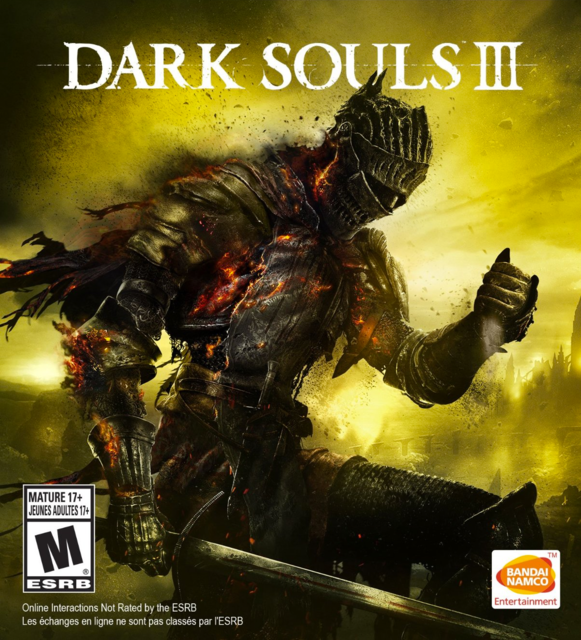
As we continue part two of our look at Dark Souls 3's bosses, and to a lesser extent the regions that they occupy, I've been considering how readily I've fallen into DS3's self-harming trap of having encounters and areas that can be so comparable to those that have come before. DS3 definitely trades in nostalgia - a certain area coming out quite overtly so - but that's no excuse to treat these newcomers as amalgams and homages of those that have come before. It's occasionally inescapable, but I hope to make more of an effort to explore this particular game's iteration of the Dark Souls world and the novel distinctions it brings.
But man, do some of these guys feel familiar.
Be sure to catch up with Part 1 if you haven't, and to likewise check out the previous Bosswatch features at the start of that article. Oh, and for spoilers' sake - if, like me, you're only partway through the game - we're covering everything that appears between the first Lord of Cinder (whom I ended Part One with) and the second and third Lords.
Catacombs of Carthus
The catacombs aren't so much distinct on their own, but distinct for being a combination of areas that have come before (yep, I'm already breaking my promise from the intro). Every Souls game thus far has an ominous network of chambers that once housed the dead, whether or not the dead in question were satisfied to rest in their tombs. The first Dark Souls had the umbral Tomb of Giants, made memorable by Vinny's ventures into the dark unknown, but these Catacombs more closely resemble the labyrinthine Undead Crypt of the second game and a touch of Sen's Fortress with its various traps, the most notable of which involve a few rolling balls of skeletons.
Carthumari Damacy shenanigans aside, however, the best part of this confusing and largely vertically descending dungeon is a cave-like area at the end close to the fog gate that leads to the boss. Here, the game surprises you two times in quick succession, and you can either fall afoul of one of these traps, both of them, or come upon an ideal scenario where you use one to neuter the other: a large throng of skeletons appear after moving into this cave area, and the bridge that leads to the boss will take a single hit before it lurches to one side and collapses. You can get in some classic Temple of Doom action by crossing the bridge, waiting for the skeletons to approach the other side and then cut the ropes, sending several of them falling to their doom. It's a cool moment, and demonstrates that - for all your nobility in attempting to save the world via kindling the true flame (or whatever) - the game offers you enough occasions where you can feel like the sneaky bad guy for a change.
High Lord Wolnir
What Wolnir represents to me is that of the spectacle boss; the one that takes you into another dimension to fight them, which gives the designers and artists free license to imagine something either utterly absurd geographically-speaking and/or a realm that seeks to unnerve you as soon as you arrive. This was certainly the case with the Four Kings fight of the original Dark Souls: the battle was set in pitch darkness in every direction, with only the ghostly forms of your foes to break up the omnipresent pitch black. That disturbing eternal darkness, as it were, is an evocatively powerful if graphically simple trick. I remember the old trading space-sim Elite spooking the heck out of me whenever my hyperdrive failed and I was momentarily trapped in Witchspace: a region of perfect darkness, the stars having all vanished, and only the motherships of the deadly alien hivemind species of the Thargoids to keep me company. At any rate, Wolnir's "arena" is darkness in all directions but for the ground, which sloped ever downwards towards what could easily be imagined as an abyssal destination that I didn't want to visit. Neither did the boss himself I'd imagine, who was a fifty foot tall skeleton of which you could only see the torso that was also sliding down this incline along with you. The lore around this guy suggested that, after abusing the powers of darkness to become the sole tyrannical warlord of his people, he sought ways to avoid the Faustian fate that his gleaned knowledge would inevitably invite. While an enormous and fearful presence, and one that commands skeleton followers from beyond the grave, this fight is one borne of desperation to avoid the abyss at all costs - for him and for you.
The fight wasn't too difficult, for all its symbolic spectacle. The boss's obvious weak points were its upper arm bones, given that they were the only parts of the guy you could reach, and each arm had a number of golden bracelets which shone brilliantly in the darkness. Didn't take long to put two-and-two together, and while the boss could still surprise you by suddenly clamoring up the hill and leaving you trapped in the dark - which was an instant kill, naturally - the sheer size of the guy meant it was easy to predict and evade his sweeps and magic attacks. After all three bracelets were gone, Wolnir was dragged into the darkness forever, and I awoke back in the boss room.
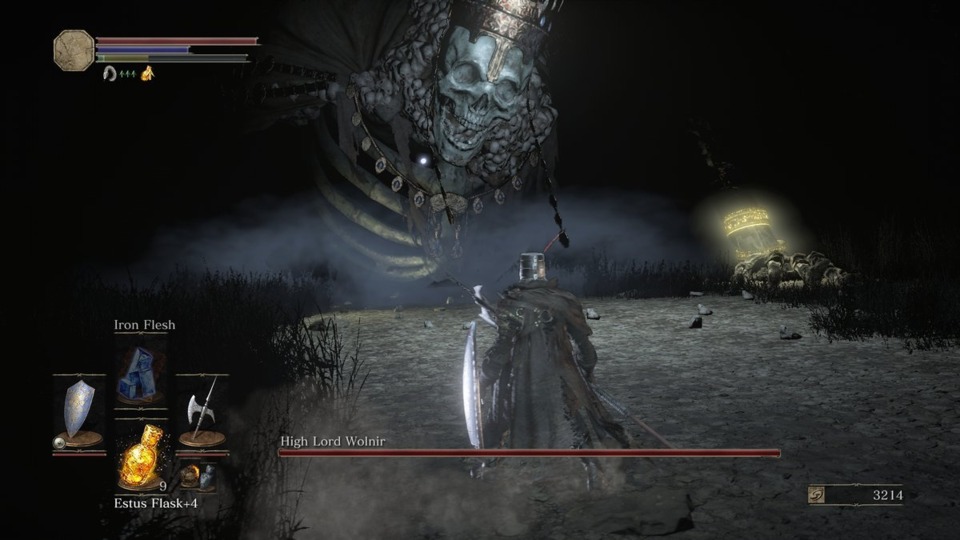
Which is where the Bloodborne comparison comes in. A lot of the samey corridors of the Catacombs reminded me deep down of the identikit Chalice Dungeons of that game, but it wasn't until I activated the Wolnir fight - which literally involved walking up to a Chalice and being teleported away - that the allusion became clear. Wolnir was one of those really cool looking bosses that developers tend to put into their trailers, but he underwhelmed when it came time to devise a sound strategy to defeat him - it would've been pretty hard not to figure it out immediately. I feel that's been a recurring issue with some of DS3's bosses, especially the larger and less human ones.
Smouldering Lake
Smouldering Lake would be your Izalith level: deep beneath the ground, where demons and lava make things incredibly uncomfortable for anyone without sufficient fire damage reduction. It begins as a gigantic open area where you're constantly pummeled by ballista fire from somewhere high above, all the while contending with some more giant crabs - in a stronger cinder mode, no less - and at least one enormous burrowing worm that can kill in one hit if you're unfortunate enough to be standing near where it just unearthed itself. There's a couple of paths down here: one leads to the basin beneath the last area of the Catacombs, above the bridge, while the other leads to the area's boss and a nearby upper route to the ballistae and the rest of the area.
While the Izalith connection is the most overt, there's also something akin to the Ash Lake area of the same game; the "exit" to the boss is obvious enough, as you can see it from the entrance, but it's simply a matter of running over there without getting killed by the enormous obstacles in the way.
OId Demon King
The Old Demon King is, like the Stray Demon, a callback to the pot-bellied hellspawn of Dark Souls. He looks impossibly old, and his arena is filled with the corpses of other demons - most are of the same portly genus, though there's a few dead Capras strewn around as well - and you get the sense that, like the humans above, the demon "race" is on its way out as well. That is, that they are as dependent on the flame for sustenance as the more civilized races, with just a handful left behind to cause you strife. I'm not certain that's what the game is going for - I see piles of corpses and just assume the worst, which I think is a rational enough response to a pile of corpses - because the demons were always part of the whole "Izalith witches summoned a cursed fire and bit off more than they could chew, or rather that they were chewed on by demons" mythos, which is a different flame irrespective of the sacred flame of the Cinder Lords that fuels human civilization. But hey, I figure if humanity's in its twilight years, the rest of the world's denizens are probably on the wane also.
As for the fight, the Old Demon King relies on many of the classic demon tricks. That is to say, fire, and a lot of it. Almost all its attacks revolve around creating flames, pools of lava or firey meteors, or hitting you with its gnarled club if it doesn't feel like being fancy. This creates a problematic boss fight in the same way the Fume Knight did - there's little you can do to mitigate the constant fire damage you'll receive, besides a handful of armor sets that offer any decent fire resistance and a few consumable items that provide a temporary boost to same. Getting in close is a bad idea, even if you intend to rely on the "get between its legs to avoid its reach" approach to larger bosses because the Old Demon King has at least three strong AoE fire attacks that it centers on itself. It becomes a battle of attrition at close range that you're unlikely to win; at least for me, each of these attacks did 60-80% damage to my health bar even when guarding, which meant an Estus after every one to avoid a fatal follow-up. So instead I took my bow out and made this a ranged battle. Let me tell you, at a distance it was far easier to avoid the guy's various AoE attacks, since they all had the same reach as its club. A fire breath attack and the aforementioned meteors were the only ones to get close to hitting me, and they both moved slowly enough to be easily avoided. It felt a bit like cheesing, especially since I didn't bring any special damaging arrows to the fight - the bow thing occurred to me mid-battle, hence the lack of prep - but I can't say it didn't work. I didn't need a single Estus after the bow came out.
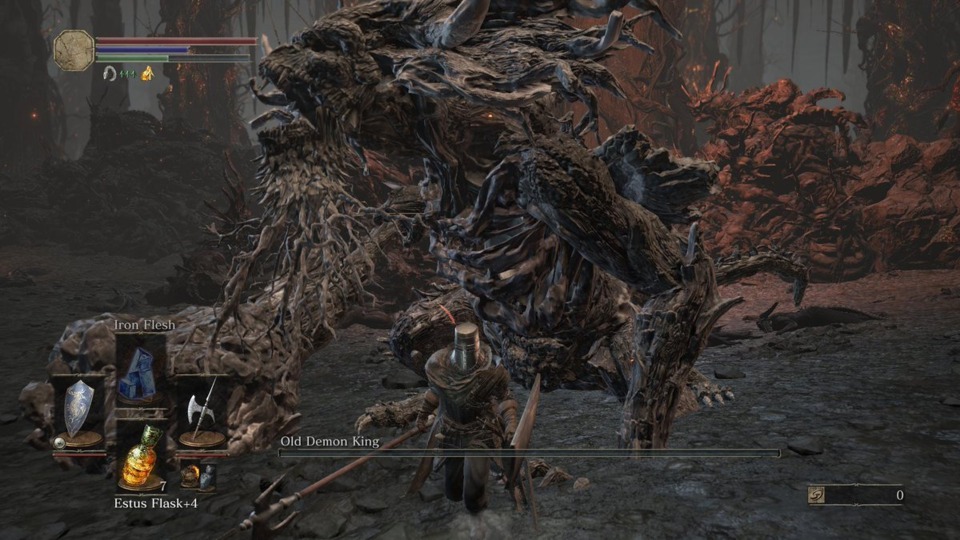
I felt sorry for the guy, actually. Not just because I was peppering him with weak arrows and he couldn't do a thing to counter it, but how at multiple parts of the fight he'd get tired and have to catch his breath. He looked extremely old, even for a demon, and it recalled Lord Gwyn in Dark Souls and how he was willing to put up a strong fight despite visual evidence that he was barely holding together. The Old Dirty King "ignites" someway into the battle - fortunately, this doesn't produce an ongoing proximity burning effect like the Fume Knight, but just makes his fire attacks stronger - but as soon as it wore off near the end of the battle, the Old Demon Bastard didn't look like he was going to get back up. He had a small amount of health left, but I half suspect that he would've stayed there crouching and wheezing until I eventually deigned to TKO the ODK no matter how long I deferred.
Irithyll of the Boreal Valley
I loved this place. While Cainhurst Castle had a snow-covered tranquil European mountain chateau feel to it, and the crystalline caves of Seath's domain were a rough approximation of a winter wonderland, the idyllic burg of Irithyll looked like something out of a Thomas Kinkade painting. That's not a knock against its visual design, just that the city was unusually picturesque for this series, and one of the few that might've been a cozy place to live before the streets were filled with ghosts and sinister magic-wielding church knights and other monsters. It reminded me of a town in Tales of Symphonia named Flanoir: another vaguely Alpine town that looked like a wonderful town to reside in, even with the year-round cold.
Irithyll eventually gives way to a less picturesque lake full of mold and weird, gross spider monsters, which in turns leads to the town's prison and sewers. Just goes to show, we can't ever have nice things in this series. The enemies are the coolest part though: the patrolling knights have this otherworldly fey quality to them, like elves. It actually kind of felt like wandering through Myth Drannor of the Forgotten Realms universe, itself an eerily beautiful location filled with the graceful, mournful shades of an impossibly ancient and alien civilization.
Pontiff Sulyvahn
Send me to the accursed darkness if this wasn't one of the most exhilarating boss fights yet, if also one of the more frustrating. The classic Souls boss experience, in so many words. Expecting something like the feral knights of the Boreal Valley I'd met in Lothric, I was surprised to discover that the Pontiff is essentially the same as the wispy tall patrol guards throughout the otherwise deserted city. Moving with the same elegance, the Pontiff proved to be exceptionally fast and exceptionally difficult to block or evade, using two swords of fire and magic to ensure that you were ill-prepared to withstand either unless you spread out the resistance rings. We even got a Gwyn moment to begin the fight, as he strolls slowly towards you, his swords suddenly igniting before he gets close enough to close the gap with a massive sweeping lunge. I may have fired a few arrows at him as he slowly made his way over, but that's his fault for showing off with an intimidating slow boss walk right out of a SNK fighter.
The first half of the fight was initially tough to survive for the sheer speed of his blows, as well how unpredictable certain combinations could be, and how relentlessly each blow struck one after the other with no pause in-between. It was then I realized that, rather than some bullshit boss-exclusive infinite stamina bar, the Pontiff was cleverly attacking with such deliberate pauses between each swing to recover the stamina lost from the previous, or at least enough of it to maintain his pace. In so doing, he created what seemed like impossibly long chains through this clever rhythmic recovery system. These pauses generally weren't long enough to allow me drink an Estus or roll out of the range of his impressive reach, but they did impart on me a lesson: I could match his rhythm and drop my guard between his swings, allowing me to recover some small amount of stamina for further blocking in much the same manner as he was preserving stamina for the next attack. The few times he ended a combo with a showstopper, as it were, I was able to sneak in a few hits before going straight back on the defensive. I imagine this boss would've been far easier with a tank who could deflect it all without flinching.
At any rate, we get the compulsory mid-battle switch-up, with the Pontiff summoning a shade that effectively doubled his combat prowess. I noticed a curious thing with this shade, however; it always struck first, with the real Pontiff following about a second after. This gave me some forewarning which attack would follow next, and as some manner of mercy to the player the duo didn't fight with the same tenacity that the Pontiff did alone. The shade also had as much HP as the regular enemies outside, and the process of resummoning it took the Pontiff a good few seconds - ideally, then, I'd narrowly block the shade's blow, evade what would be identical attack coming from the Pontiff and use the short gap to hit both with a sweeping R2 attack. This is how I eventually won the battle: by focusing on removing the shade (or hitting both, when I could) and playing defensively the rest of the time, I was able to get in a fair few hits on the Pontiff as he spent precious seconds bringing the shade back again, and kept that pattern going to the fight's end.
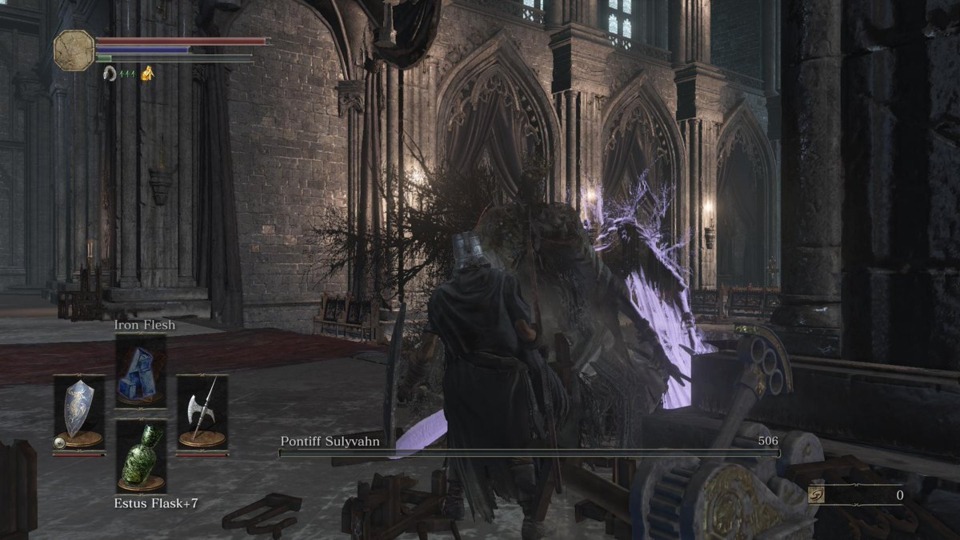
It has been a while since I met a boss this vicious. They've all been aggressive, sure, but they weren't nearly as relentless nor did they refuse to give me a moment to fall back and heal/take a breather. The weirdest aspect to the fight was the hit detection; there were times where he'd jab forward with his magic blade and hit me despite me being at his flank, while other times the model for the swords would clip right through me at the ends of their arcs for no damage. From what lore there is about the Pontiff, he seemed to be the chief cleric for whatever passes for the official religion of Lothric, though there's no clear indication what assocation he has with the Cathedral of the Deep. Almost always an issue when you have two religions sharing the same space. Anyway, I'm glad I was able to return the favor after he sent Vordt to come greet me. I suspect that we haven't seen the last of his Boreal Valley minions, even now that the good Pontiff himself has passed from this world.
Anor Londo
Of course. Of course. It wasn't enough that we have a handful of locations that closely resembled Dark Souls, but also one that comes straight out of it. It's not a perfect one-to-one of the Dark Souls Anor Londo; the geography around the spiral lift is a bit different, as is the fact that the cathedral in Irithyll apparently connects directly to the elevated balcony of Anor Londo that once overlooked Duke's Archives. It does have a few iconic visual callbacks, however: Gwyndolin's long boss corridor is still there, if you remember where the secret illusory wall is located, as well as that enormous staircase that leads to the foyer of the main palace and the palace itself. Upon entering the palace, you find that it's been some time since anyone last occupied the place. Well, anyone with any degree of sapience or decorum at least. It's kind of a mess in there.
Unfortunately, the giant blacksmith is deceased. None of the firekeepers are still around. There's only one Anor Londo occupant that should be here if his proclamation of eternal vigilance still stands, and... well, he sorta is. Sorta.
Aldrich, Devourer of Gods
When looking for the Dark Sun Gwyndolin himself, who swore to look after the seat of his father Lord Gwyn and his sister Gwynevere for the rest of his infinite days provided the player didn't kill him, we discover what happened to him: he was eaten body and soul by a hideous blob-like creature, semi-resembling those found in the foyer (now covered with debris and dirt), who gained the powers of a Lord of Cinder after munching down on the deity and absorbing his power. Its upper half is poor Gwyndolin's head and torso, used like a puppet for its still-prodigious magical talent. I suspect Crossbreed Priscilla, who was ensconced away in a magical painting within Anor Londo for her own safety, might have been devoured as well: that looks like her scythe that the torso is wielding, and Aldrich makes a similarly devastating opponent up close because of that weapon's hard-to-gauge cyclical range.
The fight resembles that of Gwyndolin's to an extent: the boss will fling magic at you, then teleport out of range once you get into melee proximity so that it might continue to safely pummel you with homing soul arrows, soul spears and a particularly nasty spell that summons a huge number of arrows that rain down from above. Another unpleasant trick is the way that it creates a damaging portal whenever it gets ready to bail, moving to whichever corner of the room happens to be the furthest away from you while you recover from the damage. The room that once housed Ornstein and Smough is now unrecognizable with the level of putrid filth covering the floor, but the pillars still serve their noble purpose of blocking most of the worst that the boss can throw at you.
At the midway point, the boss enters its "embered" form. I would later understand that this was a state common to all Cinder Lord bosses, not to mention the player character themselves, and the newly smouldering look was a telltale sign that the boss is about to pull out some cheap bullshit for its last stand. True enough, the boss became far more difficult to handle at this point, with its previous attacks doing far more damage - some instant kills - and a trail of fire left in its wake which served to damage you and knock you off-balance. Worst, however, was how the arrow storm - already the most powerful attack in Aldrich's arsenal - now lasted for somewhere between 10 and 20 seconds and followed you around the room. Getting caught in its path meant getting hit several times a second from some highly damaging magic arrows, which was more or less certain death. And if they didn't kill you, the boss continued to fling magic at you as you focused intently on avoiding the arrows for as long as your stamina held out. So many times I'd be madly rolling around the room like Captain Kirk's stunt double only to be hit from the side by an instant-death scythe swing I wasn't looking out for.

Overall, while this trip back to a prominent Dark Souls location was presumably meant to be a nostalgic throwback, it was actually kind of a bummer. Not just because an area was recycled wholesale, but because of all the maladies that befell it in the interim. It was like strolling through the destroyed Tristram near the start of Diablo 2 and catching a glimpse of Wirt's body, or being forced to put down the demonic living corpse of the humble blacksmith Griswold. I even went up to see Gwynevere's location, but all that was there was a ring and a tattered old chaise lounge (albeit a gigantic one). At least all those wonderful Silver Knight dragonbow archers were still alive...
Profaned Capital
I was expecting something like Dark Souls 2's The Pit for this area: a subterranean location deep beneath the Earth that housed the third of the four Cinder Lords I was sent to "convince" to come back to their thrones at Firelink Shrine. Really, though, this was an oddly compact location that split at its first bonfire: one went to an optional swamp area and a church filled with what I can only call Giant Hand-Faced Babies, which was some messed up shit, and also led to a new vendor for Firelink and my old pal Siegward the Onion Knight. The second path lead down a ladder to a small area filled with fireball-tossing nuns and the boss door. In fact, Anor Londo felt deceptively short too. I wonder if the game just ran out of ideas when it came to extending these locations via shortcuts and the like?
Anyway, the Profaned Capital made an impression as an ancient city crumbling away into nothingness, almost in the literal sense as it amounted to a handful of buildings and bridges floating over an abyss,, but I did wish it was a little longer.
Yhorm the Giant
This fight was messed up with its level of challenge, but also presented one of the cooler nostalgic throwbacks in the series: the return of the Storm Ruler. Before that, though, some boss design pre-amble. The game's masterstroke when it comes to describing how bosses came to be the unbelieveable badasses you're meant to cut down, is that it hides all this lore in items you typically earn only after the boss has been defeated. That means that there's little room for sympathy in the moment, unless the boss or its music has been created specifically to evoke a sorrowful feeling. Yhorm the Giant has a semi-tragic backstory as a belvoed war veteran who was elevated to a position of power, and volunteered to become a Lord of Cinder even though he knew that it would alienate him from his friends and subjects and eventually corrupt his soul.
He's also an immensely tall giant who vaguely resembles the giants of Dark Souls 2, only with a face. It's the face part that makes me wonder if he wasn't some kind of half-breed. The guy has a sword and shield, the former being the same evil-looking saw that the large villagers hit you with back in the Undead Settlement. Likewise, Yhorm has an attack variant where he double-hands this saw with a second grip further down the blade and chops down with a frightening amount of force. Naturally this, and really almost all of his attacks, are effectively an instant kill if you get hit by it and aren't blocking. He also has an immense amount of health - about ten times that of any other boss faced so far, I'd roughly say - and if you tried to fight him normally, you'd be in for an hours-long battle of attrition. That's even accounting for how easy it is to avoid his attacks by running through his legs or moving to his flank, since in an endurance battle it's more a matter of time than skill.
Yet there's a special condition to this fight and it involves the aforementioned Storm Ruler. Once used to cut an enormous demonic manta ray out of the sky all the back in Demon's Souls, the Storm Ruler is capable of producing a massive vertical slice of wind that does incredible damage to Yhorm and to no other enemy in the game. The weapon's mechanics have been altered slightly though; you have to prep it for several seconds before it becomes charged, and during this time your stamina doesn't recharge and nor can you defend yourself. You can't even move, really, at least not at a rate that makes it possible to evade attacks. The trick to this fight is to find opportunities to charge the sword and then find an opportunity to use that power, as it is the only realistic way to win the battle. This forces you to adopt a very specific strategy of evading attacks and sitting there for a few tense seconds to get the wind slash prepared, all the while needing to stop charging for a moment to evade whatever one-hit-KO swing is being thrown at you by your burly opponent. I kind of liked the dynamic this battle created: both you and your opponent had a hell of a time trying to hit the other with a critical blow, but if either of you pulled it off it would be devastating.
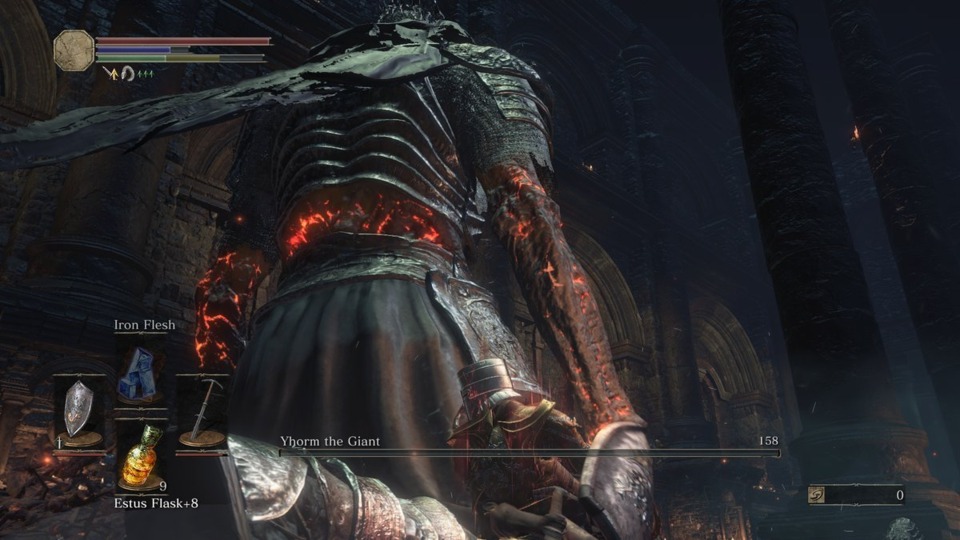
Sadly, while I did have my good friend Siegward for the first attempt at this boss, between trying to figure out how Siggy had found himself a Storm Ruler and where I could get one - the chip damage I was doing with my otherwise reliable halberd suggested that the Storm Ruler was my best bet - he was defeated after keeping the boss busy for too long. There's only so much abuse a tank can take before being battered into submission. He ultimately gave me the strategy I needed to defeat Yhorm, but the cost was far too great. He's toasting and napping with Onion Jesus now. I'll be sure to pour out a Siegbrau in his honor.
That's probably a good place to stop for Part 2, since the game just decided to take over for a major cutscene. I've no idea how many more bosses are left, though there's at least two if the usual story route is any indication: the last Lord of Cinder, and then some giant end of game boss fight that opens up once all the Lords have been put in their place. Hopefully I'll have enough for another entry, but then it's not like these couldn't be a little shorter. See you next time, Ashen Ones.
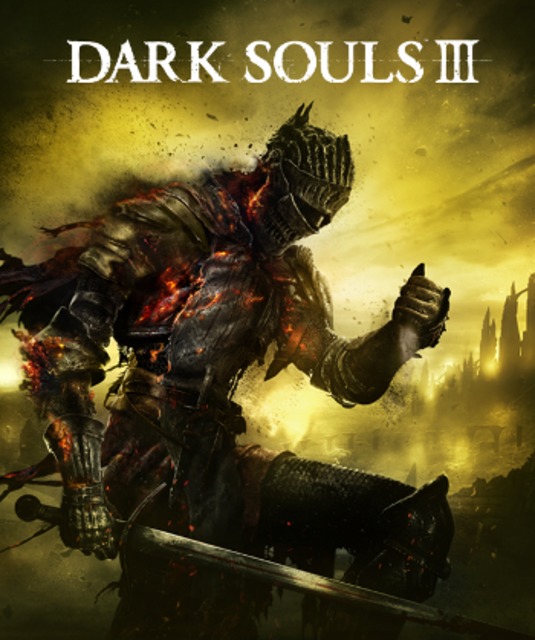
Log in to comment